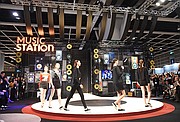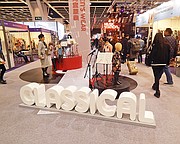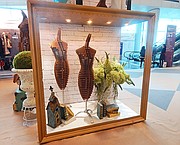Hong Kong Fashion Week Turns Focus Toward Asia
Trade Shows
As of Thursday, January 28, 2016
HONG KONG – The new Taylor Swift collection that has an all-American girl vibe didn’t debut in New York or Paris but launched its first looks in a fashion show at Hong Kong Fashion Week.
And the cute T-shirts, scalloped skirts and thigh-touching dresses won’t be sold in the United States or Europe but in China. In August, the line started to be sold online at JD.com and Alibaba, but Chinese retailers will also have a chance to snap up the collection, which retails for $20 to $65.
Kate Liegey, who designed the collection with the country western singer, said she saw a big market in China for the brand. “Taylor has such a tremendous fan base in China that is incredibly loyal,” said Liegey, who is the chief creative officer for Heritage66Company, the Nashville-basedbranding company behind manufacturing the line, geared toward women between the ages of 15 and 30. “They want American brands in China,” Liegey noted.
The Chinese economy may be slowing down, but there is a growing opportunity to sell creatively designed goods in a country with 1.4 billion people.
That fact has not been lost on the organizers of Hong Kong Fashion Week, which is increasingly moving its focus to China and other Asian countries instead of Europe and the United States.
At the recent show, held Jan. 18–21 at the Hong Kong Convention & Exhibition Centre, there seemed to be more Asian buyers attending the show than Westerners. Entire groups of Asian buyers were taking tours with Hong Kong Fashion Week guides holding up flags to keep the buyers from getting lost.
This year, for the first time since 2003, there was no World Boutique—which was geared as a higher-end designer section that normally had 300 exhibitors from Asia, Europe and the United States.
Instead, the Hong Kong Trade Development Council, which organizes the show, has decided to move World Boutique to Sept. 7–10 and call it CentreStage. The new show will be open to fashion designers, companies with original brands and licensees of brand names with the idea of about 200 exhibitors participating in the next show. There will be 60 fashion shows in four days with Asian celebrities attending many of the events. The last day of the show will be open to consumers.
C.F. Ng, senior exhibitions manager for the Hong Kong Trade Development Council, said the event will try to attract emerging designers who offer a fresh look. The show will be marketed to companies in Japan, South Korea, China, Taiwan, Thailand and Indonesia as well as to European and U.S. companies interested in reaching the Asian market. “It will consist primarily of Asian designers targeted for the Asian market,” Ng said.
Hong Kong Fashion Week’s shifting demographics underscore that more European and U.S. buyers are now going directly to China to source their products or already have an established relationship with Hong Kong and Chinese factories—which made up more than half of the 1,500 exhibitors at this January’s Hong Kong Fashion Week.
Other sourcing executives are looking more toward Vietnam, Cambodia, Indonesia and Bangladesh for factories where garment workers’ wages are more than half of that in China.
As China shifts from a manufacturing hub to a country that buys consumer products and services, the call for more Westernized apparel is on the upswing.
That was evident to Liegey, who has spent more than 25 years sourcing clothing in China for companies such as Jordache, Polo Ralph Lauren and Tommy Hilfiger. She now has a Chinese business license and has developed an anti-counterfeit hangtag to fight Taylor Swift knockoffs, which have been rampant in the areas of perfume, guitars, shoes, purses, bathing suits and hats.
Now that China has relaxed its one-child policy to allow two children per couple, there is expected to be an explosion of opportunities in the clothing, shoes and accessories market, said Lawrence Leung, the committee chairman of the Knitwear Innovation & Design Society in Hong Kong. He is also the managing director of Sun Hing Knitting Factory, which makes sweaters in China. “There could be 24 million new consumers [by 2030],” he said.
The recent Hong Kong Fashion Week saw about 530 exhibitors from China and another 400 from Hong Kong while India had a pavilion with 52 exhibitors. New to the show were companies from Myanmar, Vietnam, the Philippines, Romania, Uzbekistan and New Zealand.
Many exhibitors felt buyer traffic was down this January compared with previous years. “My feeling is there aren’t as many visitors as last time and there are not that many buyers from Europe or the United States,” said William Yeung, general merchandise manager for Fenix Fashion Ltd. in Hong Kong, which makes knit dresses, sweaters and outerwear in three factories in southern China. “I think the Chinese buyers are becoming our main buyers.”
This was the fifth time at the show for Nicky Parwani, sales manager for Grand Apparels Designs in Hong Kong, which makes shoes and handbags as well as clothing. “The show is slow, but we have a few potential clients,” he said.
One coup for Parwani was having a sourcing executive from Zara’s office in Shanghai, China, stop by the booth. “I’ve been trying to call their office and get an interview for some time now,” he said.
This was the first visit to the show for Steen Adstofte, a men’s accessories buyer for wholesaler Philipsons in Denmark. He was on his way to China and decided to stop by to check on new suppliers and factories. “This is a nice-sized show, and there are plenty of exhibitors,” he said. “I have found some nice new contacts, so I think it was two days well spent.”
David Diaz Dominguez, a buyer for Spanish childrenswear retailer Mayoral, has come to the show several times because it is based near the company’s sourcing office in Shanghai. “I come here to look for sources outside of China,” he said. “If you can find one or two good sources, that is good enough.”





